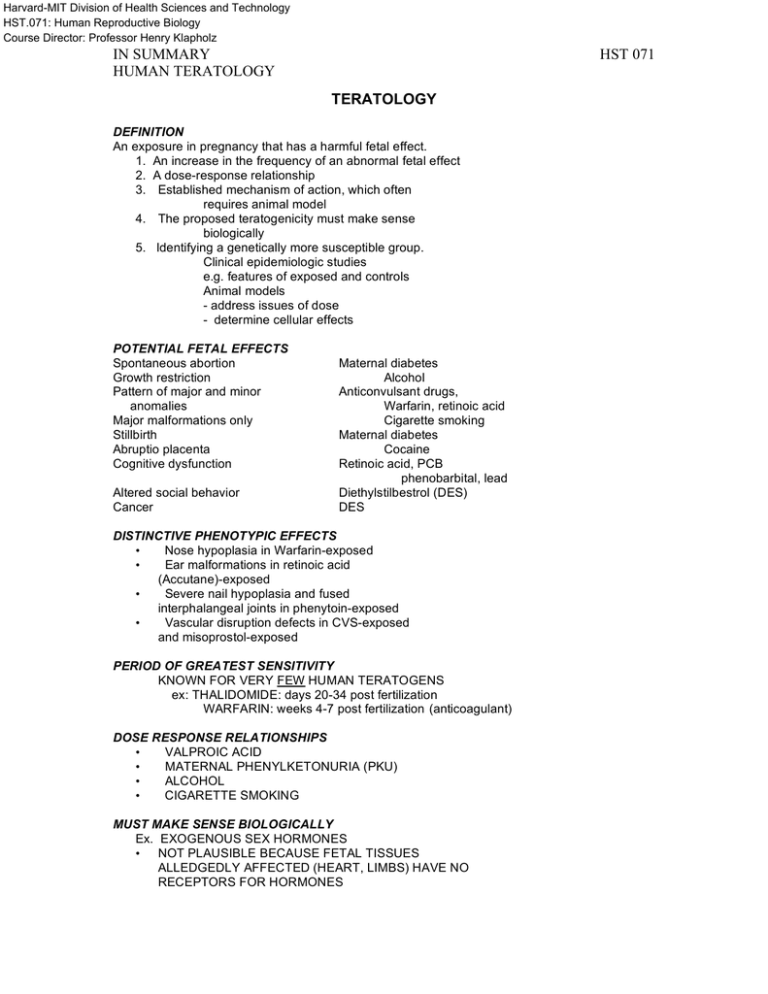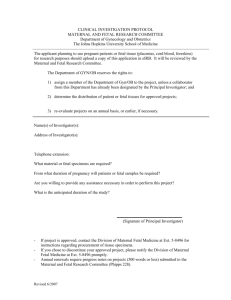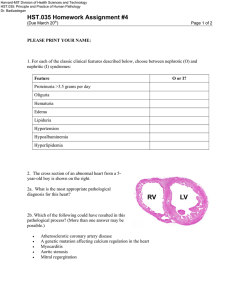Harvard-MIT Division of Health Sciences and Technology HST.071: Human Reproductive Biology
advertisement

Harvard-MIT Division of Health Sciences and Technology HST.071: Human Reproductive Biology Course Director: Professor Henry Klapholz IN SUMMARY HUMAN TERATOLOGY HST 071 TERATOLOGY DEFINITION An exposure in pregnancy that has a harmful fetal effect. 1. An increase in the frequency of an abnormal fetal effect 2. A dose-response relationship 3. Established mechanism of action, which often requires animal model 4. The proposed teratogenicity must make sense biologically 5. Identifying a genetically more susceptible group. Clinical epidemiologic studies e.g. features of exposed and controls Animal models - address issues of dose - determine cellular effects POTENTIAL FETAL EFFECTS Spontaneous abortion Growth restriction Pattern of major and minor anomalies Major malformations only Stillbirth Abruptio placenta Cognitive dysfunction Altered social behavior Cancer Maternal diabetes Alcohol Anticonvulsant drugs, Warfarin, retinoic acid Cigarette smoking Maternal diabetes Cocaine Retinoic acid, PCB phenobarbital, lead Diethylstilbestrol (DES) DES DISTINCTIVE PHENOTYPIC EFFECTS • Nose hypoplasia in Warfarin-exposed • Ear malformations in retinoic acid (Accutane)-exposed • Severe nail hypoplasia and fused interphalangeal joints in phenytoin-exposed • Vascular disruption defects in CVS-exposed and misoprostol-exposed PERIOD OF GREATEST SENSITIVITY KNOWN FOR VERY FEW HUMAN TERATOGENS ex: THALIDOMIDE: days 20-34 post fertilization WARFARIN: weeks 4-7 post fertilization (anticoagulant) DOSE RESPONSE RELATIONSHIPS • VALPROIC ACID • MATERNAL PHENYLKETONURIA (PKU) • ALCOHOL • CIGARETTE SMOKING MUST MAKE SENSE BIOLOGICALLY Ex. EXOGENOUS SEX HORMONES • NOT PLAUSIBLE BECAUSE FETAL TISSUES ALLEDGEDLY AFFECTED (HEART, LIMBS) HAVE NO RECEPTORS FOR HORMONES IN SUMMARY HUMAN TERATOLOGY • FDA REMOVED WARNING FROM PACKAGE INSERT Ex. BENDECTIN (VITAMIN B6 AND ANTIHISTAMINE) • SCIENTIFIC EVIDENCE LACKING • DRUG RE-INTRODUCED IN CANADA GENETICALLY MORE SUCEPTIBLE GFROUPS 1. CIGARETTE SMOKING 2. ALCOHOL 3. FOLIC ACID DEFICIENCY HST 071 IN SUMMARY HUMAN TERATOLOGY HST 071 SPINA BIFIDA DEFINITION: Defect in closure of neural tube in lumbar or thoracic region PREVALENCE: 0.4 per 1,000 U.S. Caucasians 0.4 per 1,000 African-Americans 0.6 per 1,000 Hispanics ETIOLOGY: Combined effect of genetic and nongenetic factors CANDIDATE GENES: methylenetetrahydrofolate reducate (MTHFR) [C677T]; methionine synthase, sonic hedgehog, uncoupling protein 2 ENVIRONMENTAL FACTORS: Folic acid deficiency, maternal diabetes mellitus, maternal obesity, anticonvulsant drugs (Tegretol and Depakote) MOST EXPOSURES HAVE NOT BEEN STUDIED ♦ MOST STUDIES FOCUS ON MAJOR MALFORMATIONS ONLY ♦ LITTLE DATA ON EFFECTS ON BEHAVIOR AND I.Q. ♦ FEW STUDIES OF DERMAL EXPOSURES AIRBORNE EXPOSURES ♦ NEED TO ESTABLISH MOLECULAR BASIS FOR TERATOGENESIS COUNSELING FOR EXPOSURES: IT IS NOT GENETIC COUNSELING MICROTIA DEFINITION: ASSOCIATIONS: PREVALENCE: GENETICS: MALFORMED AND UNDERDEVELOPED EAR; MILD TO SEVERE; USUALLY UNILATERAL RIGHT > LEFT TYPICALLY ISOLATED; NO INCREASE IN KIDNEY ABNORMALITIES HEARING LOSS: 50 TO 70dB 1 IN 10,000 7% EMPIRIC RECURRENCE RISK Content removed due to copyright restrictions. Please see: Friedman, J.M., and Janine E. Polifka. Teratogenic Effects of Drugs: A Resource for Clinicians: TERIS. Baltimore, MD: Johns Hopkins University Press, 1994. ISBN: 0801848008. IN SUMMARY HUMAN TERATOLOGY HST 071 ACUTANE 35% Have Major Malformations • Conotruncal Heart Defects • Cranial Nerve Palsies • Absence of Vermis of Cerebellum • Moderate to Severe Mental Retardation 25% Of Children With No Malformations Are Mentally Retarded PHYSICIAN’S DESK REFERENCE (PDR) SECTION ON RISKS IN PREGNANCY DESIGNED TO PROTECT LIBILITY TWO SYSTEMATIC STUDIES SHOWED POOR CORRELATION BETWEEN CATEGORIES A, B, C, D AND X WITH CLINICAL DATA AVAILABLE STUDY OF ALL DRUGS APPROVED BY FDA 1980-2000 468 DRUGS: 80% “RISK UNDETERMINED” USED ONLINE “TERIS” AS SOURCE POOR CORRELATION OF TERIS RATINGS AND FDA DRUG CATEGORIES (A, B, C, D & X) FOR 163 DRUGS KAPPA STATISTIC = 0.08 ± 0.04 OTIS Example: Centers collaborate to identify exposed pregnancies and organize follow-up exams. Examples: asthma medication leflunomide (Arava) Outcomes: body and head size, dysmorphic features, major malformations TERATOGEN COUNSELING VS GENETIC COUNSELING ALIKE: PREPARATION FOR MEETING COMMUNICATION RISK ASSESSMENT SPERM OR EGG DONOR DIFFERENT: PERIOD OF EXPOSURE ALTERNATIVE TREATMENTS EGG DONOR PRENATAL DIAGNOSIS LIMITED PREVENTION: AVOIDANCE IN SUMMARY HUMAN TERATOLOGY RECOGNIZED HUMAN TERATOGENS (2004) 1. DRUGS Aminopterin/amethopterin Androgenic hormones Angiotensin converting enzyme(ACE) inhibitors Busulfan Carbamazepine Chlorobiphenyls Cocaine Cyclophosphamide Cyclosporin Diethylstilbestrol Etretinate Fluconazole Heroin/methadone Iodide Isotretinoin (13-cis-retinoic acid) Lithium Methimazole Phenobarbital Phenytoin Propylthiouracil Prostaglandin Tetracycline Thalidomide Trimethadione/paramethadione Valproic acid Warfarin 2. HEAVY METALS Lead Mercury 3. RADIATION Cancer therapy 4. MATERNAL CONDITIONS Alcohol Insulin-dependent diabetes mellitus Iodide deficiency Maternal phenylketonuria Myasthenia gravis Obesity, severe Smoking cigarettes/marijuana Systemic lupus erythematosus Vitamin A deficiency 5. INTRAUTERINE INFECTIONS Cytomegalovirus Herpes simplex HST 071 IN SUMMARY HUMAN TERATOLOGY HST 071 Parvovirus Rubella Syphilis Toxoplasmosis Varicella Venezuelan equine encephalitis Virus 6. OTHER EXPOSURES Chorionic Villus Sampling (CVS) Dilation and Curettage (D & C) Gasoline fumes (excessive) Heat Hypoxia Intracytoplasmic Sperm Injection (ICSI) Methyl isocyanate Methylene blue Polychlorinated biphenyls Toluene (excessive; glue sniffing) Trauma, blunt FUNDAMENTAL QUESTIONS 1. What is a teratogen? 2. Describe the embryologic time line for teratogenesis? 3. What are the specific abnormalities that are seen in the fetal Warfarin syndrome? 4. What are the specific abnormalities that are seen the fetal alcohol syndrome? 5. What are the specific abnormalities that are seen in the fetal hydantoin syndrome? 6. List 10 known anatomic teratogenic fetal effects of drugs? 7. Name 7 infectious diseases known to be teratogenic? In what trimester are these of greatest concern? 8. Name 7 mechanical causes of teratogenic effects? 9. What are the adverse fetal effects of prenatal cigarette exposure? 10. What are the effects of fetal exposure to Accutane? How may these be prevented? 11. What is a good reference source to use in counseling patients about teratogenic effects of drugs? IN SUMMARY HUMAN TERATOLOGY HST 071






